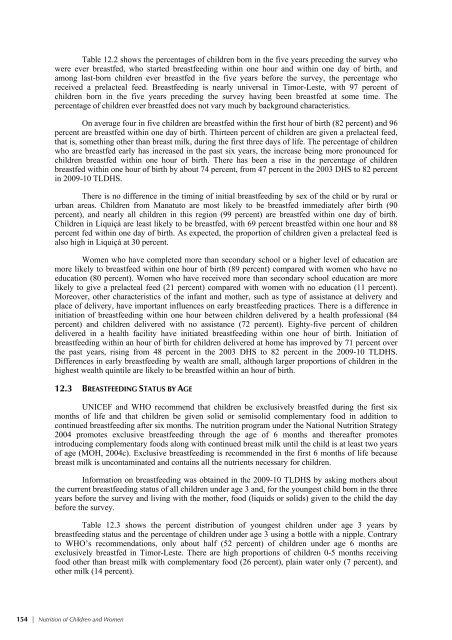Demographic and Health Survey 2009-10 - Timor-Leste Ministry of ...
Demographic and Health Survey 2009-10 - Timor-Leste Ministry of ...
Demographic and Health Survey 2009-10 - Timor-Leste Ministry of ...
Create successful ePaper yourself
Turn your PDF publications into a flip-book with our unique Google optimized e-Paper software.
Table 12.2 shows the percentages <strong>of</strong> children born in the five years preceding the survey who<br />
were ever breastfed, who started breastfeeding within one hour <strong>and</strong> within one day <strong>of</strong> birth, <strong>and</strong><br />
among last-born children ever breastfed in the five years before the survey, the percentage who<br />
received a prelacteal feed. Breastfeeding is nearly universal in <strong>Timor</strong>-<strong>Leste</strong>, with 97 percent <strong>of</strong><br />
children born in the five years preceding the survey having been breastfed at some time. The<br />
percentage <strong>of</strong> children ever breastfed does not vary much by background characteristics.<br />
On average four in five children are breastfed within the first hour <strong>of</strong> birth (82 percent) <strong>and</strong> 96<br />
percent are breastfed within one day <strong>of</strong> birth. Thirteen percent <strong>of</strong> children are given a prelacteal feed,<br />
that is, something other than breast milk, during the first three days <strong>of</strong> life. The percentage <strong>of</strong> children<br />
who are breastfed early has increased in the past six years, the increase being more pronounced for<br />
children breastfed within one hour <strong>of</strong> birth. There has been a rise in the percentage <strong>of</strong> children<br />
breastfed within one hour <strong>of</strong> birth by about 74 percent, from 47 percent in the 2003 DHS to 82 percent<br />
in <strong>2009</strong>-<strong>10</strong> TLDHS.<br />
There is no difference in the timing <strong>of</strong> initial breastfeeding by sex <strong>of</strong> the child or by rural or<br />
urban areas. Children from Manatuto are most likely to be breastfed immediately after birth (90<br />
percent), <strong>and</strong> nearly all children in this region (99 percent) are breastfed within one day <strong>of</strong> birth.<br />
Children in Liquiçá are least likely to be breastfed, with 69 percent breastfed within one hour <strong>and</strong> 88<br />
percent fed within one day <strong>of</strong> birth. As expected, the proportion <strong>of</strong> children given a prelacteal feed is<br />
also high in Liquiçá at 30 percent.<br />
Women who have completed more than secondary school or a higher level <strong>of</strong> education are<br />
more likely to breastfeed within one hour <strong>of</strong> birth (89 percent) compared with women who have no<br />
education (80 percent). Women who have received more than secondary school education are more<br />
likely to give a prelacteal feed (21 percent) compared with women with no education (11 percent).<br />
Moreover, other characteristics <strong>of</strong> the infant <strong>and</strong> mother, such as type <strong>of</strong> assistance at delivery <strong>and</strong><br />
place <strong>of</strong> delivery, have important influences on early breastfeeding practices. There is a difference in<br />
initiation <strong>of</strong> breastfeeding within one hour between children delivered by a health pr<strong>of</strong>essional (84<br />
percent) <strong>and</strong> children delivered with no assistance (72 percent). Eighty-five percent <strong>of</strong> children<br />
delivered in a health facility have initiated breastfeeding within one hour <strong>of</strong> birth. Initiation <strong>of</strong><br />
breastfeeding within an hour <strong>of</strong> birth for children delivered at home has improved by 71 percent over<br />
the past years, rising from 48 percent in the 2003 DHS to 82 percent in the <strong>2009</strong>-<strong>10</strong> TLDHS.<br />
Differences in early breastfeeding by wealth are small, although larger proportions <strong>of</strong> children in the<br />
highest wealth quintile are likely to be breastfed within an hour <strong>of</strong> birth.<br />
12.3 BREASTFEEDING STATUS BY AGE<br />
UNICEF <strong>and</strong> WHO recommend that children be exclusively breastfed during the first six<br />
months <strong>of</strong> life <strong>and</strong> that children be given solid or semisolid complementary food in addition to<br />
continued breastfeeding after six months. The nutrition program under the National Nutrition Strategy<br />
2004 promotes exclusive breastfeeding through the age <strong>of</strong> 6 months <strong>and</strong> thereafter promotes<br />
introducing complementary foods along with continued breast milk until the child is at least two years<br />
<strong>of</strong> age (MOH, 2004c). Exclusive breastfeeding is recommended in the first 6 months <strong>of</strong> life because<br />
breast milk is uncontaminated <strong>and</strong> contains all the nutrients necessary for children.<br />
Information on breastfeeding was obtained in the <strong>2009</strong>-<strong>10</strong> TLDHS by asking mothers about<br />
the current breastfeeding status <strong>of</strong> all children under age 3 <strong>and</strong>, for the youngest child born in the three<br />
years before the survey <strong>and</strong> living with the mother, food (liquids or solids) given to the child the day<br />
before the survey.<br />
Table 12.3 shows the percent distribution <strong>of</strong> youngest children under age 3 years by<br />
breastfeeding status <strong>and</strong> the percentage <strong>of</strong> children under age 3 using a bottle with a nipple. Contrary<br />
to WHO’s recommendations, only about half (52 percent) <strong>of</strong> children under age 6 months are<br />
exclusively breastfed in <strong>Timor</strong>-<strong>Leste</strong>. There are high proportions <strong>of</strong> children 0-5 months receiving<br />
food other than breast milk with complementary food (26 percent), plain water only (7 percent), <strong>and</strong><br />
other milk (14 percent).<br />
154 | Nutrition <strong>of</strong> Children <strong>and</strong> Women
















